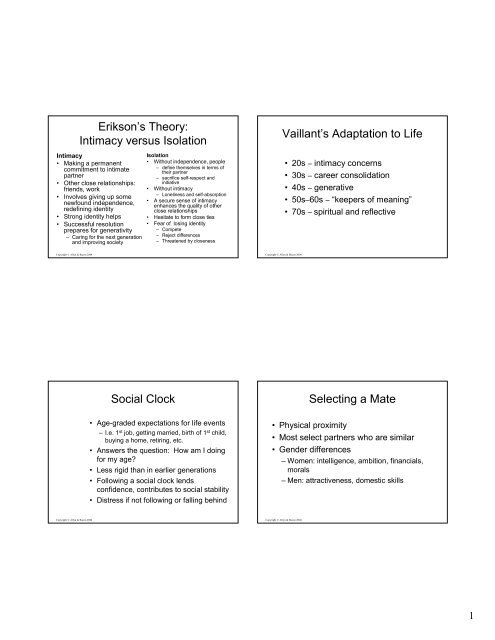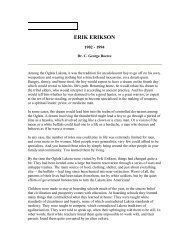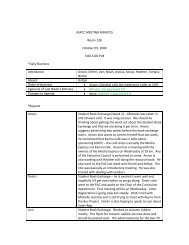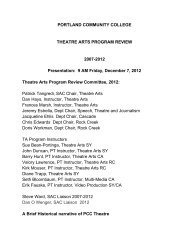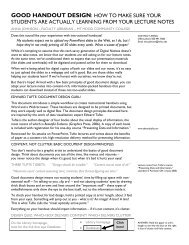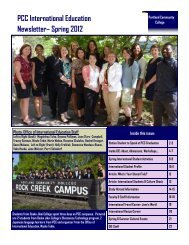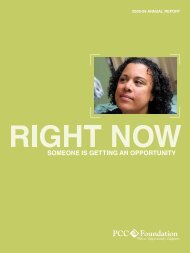Erikson's Theory: Intimacy versus Isolation Vaillant's Adaptation to ...
Erikson's Theory: Intimacy versus Isolation Vaillant's Adaptation to ...
Erikson's Theory: Intimacy versus Isolation Vaillant's Adaptation to ...
You also want an ePaper? Increase the reach of your titles
YUMPU automatically turns print PDFs into web optimized ePapers that Google loves.
Copyright © Allyn & Bacon 2004<br />
Erikson’s <strong>Theory</strong>:<br />
<strong>Intimacy</strong> <strong>versus</strong> <strong>Isolation</strong><br />
<strong>Intimacy</strong><br />
• Making a permanent<br />
commitment <strong>to</strong> intimate<br />
partner<br />
• Other close relationships:<br />
friends, work<br />
• Involves giving up some<br />
newfound independence,<br />
redefining identity<br />
• Strong identity helps<br />
• Successful resolution<br />
prepares for generativity<br />
– Caring for the next generation<br />
and improving society<br />
Copyright © Allyn & Bacon 2004<br />
Social Clock<br />
<strong>Isolation</strong><br />
• Without independence, people<br />
– define themselves in terms of<br />
their partner<br />
– sacrifice self-respect and<br />
initiative<br />
• Without intimacy<br />
– Loneliness and self-absorption<br />
• A secure sense of intimacy<br />
enhances the quality of other<br />
close relationships<br />
• Hesitate <strong>to</strong> form close ties<br />
• Fear of losing identity<br />
– Compete<br />
– Reject differences<br />
– Threatened by closeness<br />
• Age-graded expectations for life events<br />
– I.e. 1 st job, getting married, birth of 1 st child,<br />
buying a home, retiring, etc.<br />
• Answers the question: How am I doing<br />
for my age?<br />
• Less rigid than in earlier generations<br />
• Following a social clock lends<br />
confidence, contributes <strong>to</strong> social stability<br />
• Distress if not following or falling behind<br />
Vaillant’s <strong>Adaptation</strong> <strong>to</strong> Life<br />
• 20s – intimacy concerns<br />
• 30s – career consolidation<br />
• 40s – generative<br />
• 50s–60s – “keepers of meaning”<br />
Copyright © Allyn & Bacon 2004<br />
Copyright © Allyn & Bacon 2004<br />
• 70s – spiritual and reflective<br />
Selecting a Mate<br />
• Physical proximity<br />
• Most select partners who are similar<br />
• Gender differences<br />
– Women: intelligence, ambition, financials,<br />
morals<br />
– Men: attractiveness, domestic skills<br />
1
Childhood Attachment and Adult<br />
Romantic Relationships<br />
Attachment<br />
His<strong>to</strong>ry<br />
Secure<br />
Avoidant<br />
Resistant<br />
Copyright © Allyn & Bacon 2004<br />
Same-Sex<br />
Friendships<br />
Copyright © Allyn & Bacon 2004<br />
Working Model<br />
Comfortable with<br />
intimacy; unafraid of<br />
abandonment<br />
Stress<br />
independence,<br />
mistrust, anxiety<br />
about closeness<br />
Seek quick love,<br />
complete merging<br />
Adult Relationships<br />
Trust, happiness,<br />
friendship<br />
Jealousy, emotional<br />
distance, little physical<br />
pleasure<br />
Jealousy, desperation,<br />
emotional highs & lows<br />
Gender and Friendship<br />
• Gender differences<br />
– Women’s more<br />
intimate<br />
• Individual differences<br />
– Longer friendships<br />
more intimate<br />
– Single people more<br />
intimate with friends<br />
Other-Sex<br />
Friendships<br />
• Fewer, shorter-lasting<br />
than same-sex<br />
– Educated, employed<br />
women have most<br />
• Benefits <strong>to</strong> both genders<br />
– Men: opportunity for<br />
expression<br />
– Women: new views<br />
• Sexual attraction must be<br />
considered<br />
Sternberg’s Triangular <strong>Theory</strong> of Love<br />
• 3 components:<br />
– <strong>Intimacy</strong>: emotional component<br />
– Passion: physical and psychological component<br />
– Commitment: cognitive component<br />
• leads <strong>to</strong> decision <strong>to</strong> love and maintain love<br />
• Passionate love (sexual attraction) is strong at the<br />
beginning of a relationship, but then transitions <strong>to</strong><br />
companionate love (warm, trusting affection and<br />
caregiving). Commitment determines whether a<br />
relationship survives.<br />
Copyright © Allyn & Bacon 2004<br />
Copyright © Allyn & Bacon 2004<br />
Fac<strong>to</strong>rs in Loneliness<br />
Unhappiness resulting from a gap between relationships we have and those<br />
we desire<br />
Age<br />
Circumstances<br />
Personal<br />
Characteristics<br />
• Peaks in late teens, early 20s<br />
• Declines through 70s<br />
• Separated, divorced, widowed<br />
• Immigrants from collectivist cultures higher than<br />
those born in US or Canada<br />
• Socially anxious<br />
• Insecure models of attachment<br />
• Self-defeating behaviors, attitudes<br />
6<br />
2
• Early adulthood<br />
– Leaving home<br />
– Joining families in<br />
marriage<br />
– Parenthood<br />
• Middle adulthood<br />
– Launching children<br />
• Sequence of phases that<br />
characterizes<br />
development of most<br />
families<br />
Copyright © Allyn & Bacon 2004<br />
Family Life Cycle<br />
• Late adulthood<br />
– Retirement<br />
– Death of spouse<br />
Gender Differences in Marital<br />
Satisfaction<br />
Men: Just being married improves<br />
physical and mental health<br />
– Attachment, belonging, social support<br />
Women: Relationship quality is<br />
important<br />
– Overwhelming demands of many roles<br />
cause dissatisfaction<br />
Copyright © Allyn & Bacon 2004<br />
Fac<strong>to</strong>rs Related <strong>to</strong> Marital<br />
Satisfaction<br />
• Family backgrounds<br />
• Age at marriage<br />
• Length of courtship<br />
• Timing of first pregnancy<br />
• Relationship <strong>to</strong> extended family<br />
• Financial and employment status<br />
• Family responsibilities<br />
• Personality characteristics<br />
Copyright © Allyn & Bacon 2004<br />
Copyright © Allyn & Bacon 2004<br />
Transition <strong>to</strong> Parenthood<br />
• Many profound changes<br />
• Roles often become more traditional<br />
– Roles get less traditional with second birth<br />
• Marriage can be strained<br />
– Problems before children predict problems<br />
after<br />
– Sharing care predicts happiness<br />
• Later parenthood eases transition<br />
– Couple’s groups, paid leave help, <strong>to</strong>o<br />
3
Copyright © Allyn & Bacon 2004<br />
Parenting<br />
• Powerful source of adult development<br />
• With young children<br />
– Best parents work <strong>to</strong>gether as co-parenting<br />
team<br />
– Challenges: few social supports; hard <strong>to</strong> find<br />
child care<br />
• With adolescents<br />
– Brings sharp changes<br />
– Challenges: negotiation of roles,<br />
dip in marital satisfaction<br />
Copyright © Allyn & Bacon 2004<br />
Divorce Rates<br />
• Stabilized since 1980s<br />
• 45% U.S., 30% Canadian marriages<br />
– About 7% higher for remarriages soon after first<br />
marriage<br />
• First seven years, midlife<br />
most common times<br />
– Young and adolescent<br />
children involved<br />
Copyright © Allyn & Bacon 2004<br />
Cohabitation<br />
• Unmarried, sexually intimate, living<br />
<strong>to</strong>gether<br />
• Increasing<br />
• Can be preparation for marriage<br />
– North Americans who cohabit<br />
before marriage more likely <strong>to</strong><br />
divorce<br />
• Can be alternative <strong>to</strong> marriage<br />
– More accepted in Western Europe<br />
Causes and Fac<strong>to</strong>rs in Divorce<br />
• Ineffective problem solving<br />
• Separate lives<br />
• Major problems: Infidelity, money issues,<br />
substance abuse<br />
• Background fac<strong>to</strong>rs: age,<br />
religion, prior divorce, family<br />
background<br />
• SES<br />
• Gender roles, expectations<br />
Copyright © Allyn & Bacon 2004<br />
4
Copyright © Allyn & Bacon 2004<br />
Consequences of Divorce<br />
• Major change of life and self<br />
– Opportunities for positive and negative change<br />
• Immediate consequences - generally subside<br />
in 2 years<br />
– Disrupted social networks, support<br />
– Increased anxiety, depression, impulsive behavior<br />
– Traditional women, noncus<strong>to</strong>dial fathers may<br />
have more problems<br />
• New partner helps satisfaction<br />
– More important <strong>to</strong> men<br />
Challenges <strong>to</strong><br />
Women’s Career Development<br />
• Discontinuous employment<br />
– Leave for child-rearing, family care<br />
– Hinders advancement<br />
• Concentration low-paying, low-advancement<br />
jobs<br />
– Contributes <strong>to</strong> salary gap<br />
• Low self-efficacy for male-dominated fields<br />
• Gender stereotyping<br />
• Few men<strong>to</strong>rs<br />
Copyright © Allyn & Bacon 2004<br />
Copyright © Allyn & Bacon 2004<br />
Remarriage After Divorce<br />
• Most within four years of divorce<br />
– Men sooner than women<br />
• Vulnerable <strong>to</strong> breakup<br />
– Reasons for marriage<br />
• Often <strong>to</strong>o pragmatic<br />
– Carry over negative patterns<br />
– View divorce as acceptable resolution<br />
– Stepfamily stress<br />
• Takes 3-5 years <strong>to</strong> blend<br />
– Education,<br />
couples and family counseling can help<br />
Copyright © Allyn & Bacon 2004<br />
Work-Family Balance<br />
• Dual-earner marriages dominant family<br />
form<br />
– Most also parents<br />
• Role overload common problem<br />
– Especially for women<br />
• Workplace supports can help<br />
– Time flexibility<br />
5


